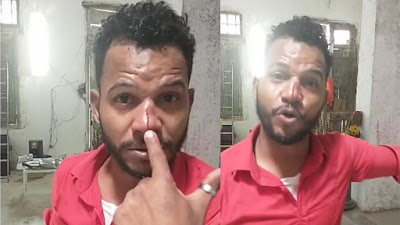#TheEternalFlame #LaLlamaEterna.
Luis Manuel Otero Alcántara has been on a hunger and thirst strike since Sunday, April 25, 2021. He is demanding that Castro regime officials:
1- Lift the police cordon on Luis Manuel Otero Alcantara in force since November 2020, and get rid of the state of siege as a practice to stop the free movement of artists, journalists and activists.
2- Return the art works that were stolen from Luis Manuel Otero Alcantara and compensate him for any damages that they’ve incurred.
3- Respect for Cuban artists and them exercising their freedoms fully.
The dictatorship has responded with repression and more repression. Amnesty International has collaborated with artist Erik Ravelo and released the following.
Amnesty International, April 29, 2021
Cuba: Amnesty International and artist Erik Ravelo launch ‘The Eternal Flame’, a digital conceptual memorial in support of San Isidro Movement and freedom of expression
 |
| Image from the video "The Eternal Flame" created by Erik Ravelo |
April 29, 2021
In response to a recent wave of detentions and harassment of members of Cuba’s San Isidro Movement – composed of artists, academics, and alternative thinkers – Amnesty International calls on artists and human rights defenders and activists across the world to join the campaign “The Eternal Flame”, in solidarity with the Movement and independent artists in the country.
“The members of the San Isidro Movement are human rights defenders who stand to protect a very basic freedom, the right to peacefully express their minds and souls. The Cuban government is clearly not ashamed of constantly harassing, detaining and surveilling them before the eyes of the international community, but they are not alone and won’t be silenced. We will continue to mobilize people around the world, including artists, to support them and to denounce these human rights violations and the inhumane and cruel treatment by Cuban authorities”, said Erika Guevara-Rosas, Americas director at Amnesty International.
In late January 2021, members of the San Isidro Movement and other human rights defenders and journalists, including artist Luis Manuel Otero Alcántara, continued to be detained or harassed by authorities. Cuba’s Minister of Culture, Alpidio Alonso Grau, reportedly assaulted people who gathered in front of the Ministry’s offices to read poetry and peacefully protest attacks on artists in recent months, in another example of the Cuban government’s long-standing assault on freedom of expression.
The January demonstrations followed a protest rarely seen in Cuba on 27 November 2020, during which hundreds of artists gathered outside the Ministry of Culture to demand dialogue with Cuban authorities on the issue of artistic freedom.
In weeks following the November protest, Amnesty International gathered evidence confirming that members of the Movement and their allies were under frightening levels of surveillance and faced arrest by police and state security officials if they left their houses, which could have amounted to house arrest under international human rights law.
During March and April of 2021, over 30 activists were reportedly under similar surveillance levels. Additionally, authorities reportedly took and destroyed some of Luis Manuel Otero’s artwork. Luis Manuel Otero has been on hunger strike for over 48 hours, in protest against these abuses and restrictions on freedom of expression.
Erik Ravelo, author of this conceptual video, is a renowned Cuban artist known as the creative mind behind Benetton’s “Unhate” campaign, which featured controversial images of world leaders kissing and earned him the Grand Prix at Cannes in 2012. For The Eternal Flame, he was inspired and supported by fellow Cuban artists and their bravery to resist against illegitimate restrictions imposed by the Cuban government on their freedom of expression.
“This project represents the flame of freedom: a flame that never goes out, a contemporary action that never ends and that is kept alive by our solidarity with artists defending freedom of expression. Freedom of expression is a fundamental human right and as artists, nobody should tell us what is okay to do or say through our art. This is why I, and other artists in the video, burn our tools, to draw parallels with what the Cuban government is doing against Cuban artists. It’s time to stop this repression and respect creative freedom,” said Erik Ravelo.
By launching “The Eternal Flame”, Amnesty International and Erik Ravelo invite artists and activists to express their solidarity with the San Isidro Movement and other human rights defenders and artists, urging Cuba’s government to stop repressing them and, instead, take overdue steps to engage in genuine dialogue to protect freedom of expression. People can show their support on social media, using the hashtags #TheEternalFlame #LaLlamaEterna.































